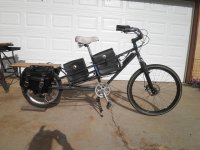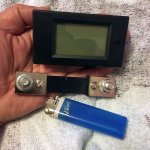Ok, 8 p should handle 30 amps. Just thought you might have 4p. But other things can still cause sag, or cells can be ruined when soldering, or they could just be fake.
The watt meter will definitely tell you if the battery is part of the problem, 8v of sag is getting pretty bad, but 4-5 v sag at starts is not unusual. Get into RC lipo if you want minimal sag, 2v or less.
My guess now is mostly just that you have the motor that does take off a bit slow in 26" wheels. They perk up nicely when you up the volts. 8)
But under normal circumstances, shitty generic cell 20 ah pack that sags 8v, Its only a slow take off if you compare it to motors with double the wire and magnets inside, that lose a lot less to heat on that first 30 feet from the stop sign. Basically, upping the volts makes it get to an efficient rpm much faster, so there is a lot less waiting for the power to build. E motors are weird, you ARE getting max torque at 0 rpm. But at 0 rpm efficiency is horrible. So torque you get to use at 0-5 rpm might be a tiny fraction of what you get by 100 rpm. The result is a very sluggish first ten feet. Like I said, pedal hard for 20 feet and you add manual torque till the E torque gets rocking.
Your motor and battery, with that controller, should be doing pretty good. But there are some reasons you might not be getting what you should. A weak contact on one big motor wire can result in a smooth running wheel in the air, but in fact you are running on 2 of the three wires. This will make it run like hell. If it stutters any under take off load, look into that sort of thing.
Tell us more about your need for torque, what are you doing? If you are just riding street, and weigh under 250 pounds, you really should have no problems. Your performance is fine. But if you are climbing walls, like west virginia or west Pennsylvania , or san Francisco hills, or towing trailers, then you might need a smaller rear wheel, and or a lot more copper wire and magnet in your motor. Yeah, its a bit slow off the line now, but you are getting around fine, and keep up with cars beside you leaving a light long enough.
Here is what I came up with for best efficiency at lower speeds ( 20 mph top), up hills, towing trailers. Same motor as you have more or less. 20 inch wheel, and the frame modified to carry up to 80 ah. Mostly ran it on 35 ah of 13s, 54v charged. Very little sag under load with that much battery aboard. Only needed 22 amps to climb big mountains. This is the way you need to head if you are climbing mountains, paved.

But for more urban riding, a similar approach to tote huge battery, but the way more powerful hub motor. To keep up with jackasses in cars in the city, ran it on 60v with RC lipo. Huge power but only about 2v of sag, and 35 mph cruise no problem. 40 mph was a bit much for the frame, but 72v would get you there.





